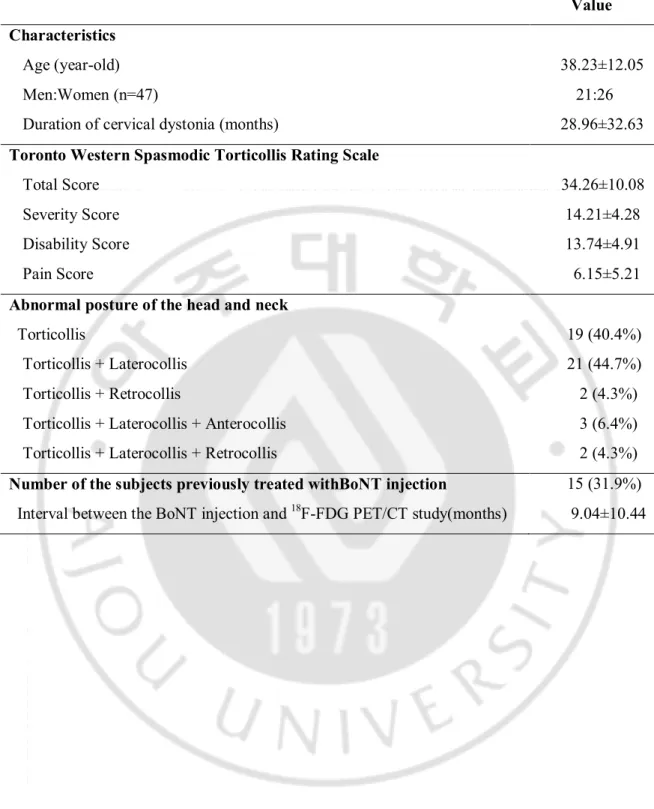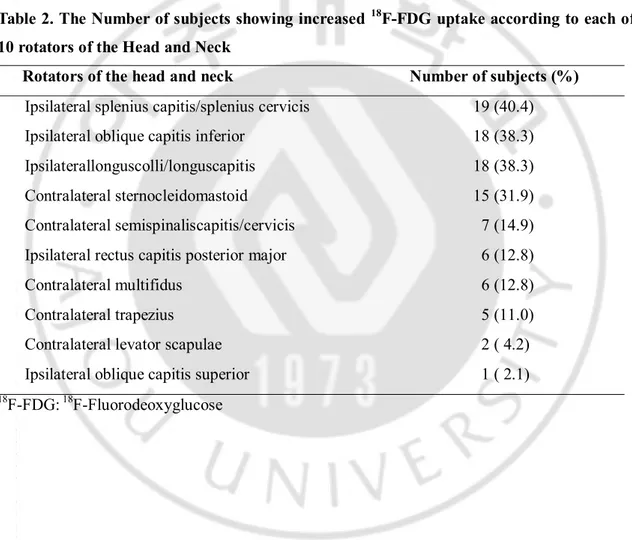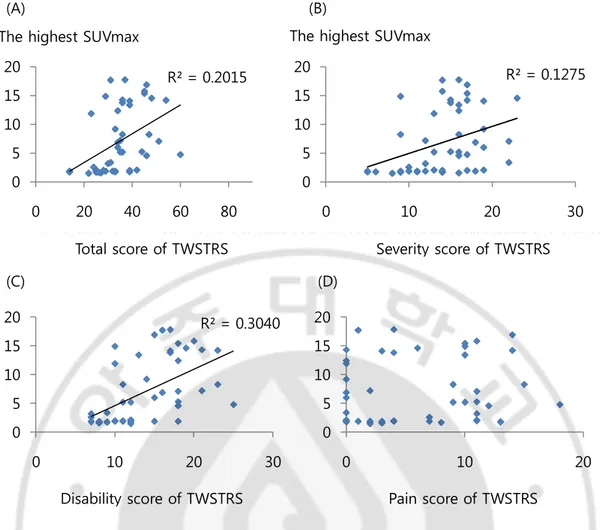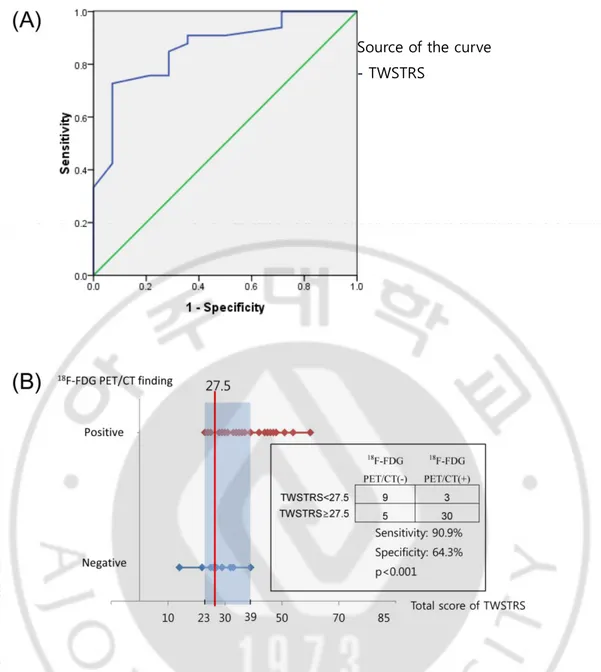저작자표시-비영리-동일조건변경허락 2.0 대한민국 이용자는 아래의 조건을 따르는 경우에 한하여 자유롭게 l 이 저작물을 복제, 배포, 전송, 전시, 공연 및 방송할 수 있습니다. l 이차적 저작물을 작성할 수 있습니다. 다음과 같은 조건을 따라야 합니다: l 귀하는, 이 저작물의 재이용이나 배포의 경우, 이 저작물에 적용된 이용허락조건 을 명확하게 나타내어야 합니다. l 저작권자로부터 별도의 허가를 받으면 이러한 조건들은 적용되지 않습니다. 저작권법에 따른 이용자의 권리는 위의 내용에 의하여 영향을 받지 않습니다. 이것은 이용허락규약(Legal Code)을 이해하기 쉽게 요약한 것입니다. Disclaimer 저작자표시. 귀하는 원저작자를 표시하여야 합니다. 비영리. 귀하는 이 저작물을 영리 목적으로 이용할 수 없습니다. 동일조건변경허락. 귀하가 이 저작물을 개작, 변형 또는 가공했을 경우 에는, 이 저작물과 동일한 이용허락조건하에서만 배포할 수 있습니다.
The threshold of clinical severity of cervical dystonia for
positive
18F-FDG PET/CT study
by
Hyun Jung Lee
The threshold of clinical severity of cervical dystonia for
positive
18F-FDG PET/CT study
by
Hyun Jung Lee
A Dissertation Submitted to The Graduate School of
Ajou University in Partial Fulfillment of the Requirements for the
Degree of Master of Medicine
Supervised by
Shin Young Yim, M.D., Ph.D.
Major in Medicine
Department of Medical Sciences
The Graduate School, Ajou University
This certifies that the dissertation
ofHyun Jung Lee is approved.
SUPERVISORY COMMITTEE
Shin-Young Yim
Young Shil An
- ABSTRACT -
The threshold of clinical severity of cervical dystonia
for positive
18F-FDG PET/CT study
Background: To examine whether there is a significant correlation between the clinical severity of cervical dystonia (CD) and 18F-fluorodeoxyglucose positron emission tomography/computed
tomography (18F-FDG PET/CT) findings and to determine the threshold of the clinical severity
of CD for acquisition of positive 18F-FDG PET/CT study findings.
Methods: Forty-seven subjects who showed torticollis as one of the symptoms of CD were included. The clinical severity of CD was evaluated with the Toronto Western Spasmodic Torticollis Rating Scale (TWSTRS) at the time of the 18F-FDG PET/CT study. The correlation
between the clinical severity of CD and the highest SUVmax was examined. The threshold of the clinical severity of CD for obtaining positive 18F-FDG PET/CT findings was determined using receiver operating characteristics curve analysis.
Results: Thirty-three subjects (70.21%) out of 47 showed positive 18F-FDG PET/CT findings.
The most frequently involved, top 3 rotators were ipsilateral splenius capitis/cervicis, oblique capitis inferior and longuscolli/capitis. The highest SUVmax of 18F-FDG PET/CT showed a
significant correlation with the TWSTRS. All subjects with a total TWSTRS of more than 39 showed positive 18F-FDG PET/CT findings, and all subjects with a total TWSTRS of 22 or less showed negative 18F-FDG PET/CT study results. The cutoff value of the total TWSTRS for
positive 18F-FDG PET/CT findings was set at 27.5, with 90.9% sensitivity and 64.3% specificity.
Conclusions: This study demonstrated a significant correlation between the clinical severity of CD and 18F-FDG PET/CT findings, providing a threshold of the clinical severity of CD for
acquisition of positive 18F-FDG PET/CT findings.In conclusion, these findings are suggestive of
the usefulness of 18F-FDG PET/CT for identification of dystonic muscles of CD with moderate
to severe severity and further studies are required to verify these findings.
TABLE OF CONTENTS
ABSTRACT ……….. i
TABLE OF CONTENTS ……….. ii
LIST OF TABLES ………... iii
LIST OF FIGURES ……….. iv
I. INTRODUCTION ………. 1
II. MATERIALS AND METHODS ……….. 3
A. Subjects ……… 3
B. Analysis of 18F-FDG PET/CT findings ………... 3
C. The correlation between the clinical severity of cervical dystonia and the highest SUVmax of the 18F-FDG PET/CT study ……… 4
D. The threshold of the clinical severity of cervical dystonia for positive 18F-FDG PET/CT study findings ………. 5
E. Statistical analysis ……….…… 5
III. RESULTS ……….... 6
A. The characteristics of the subjects……… 6
B. The number of subjects showing increased 18F-FDG uptake according to each of the 10 rotators of the head and neck in descending order………. 8
C. The correlation between the clinical severity of cervical dystonia and the highest SUVmax of the 18F-FDG PET/CT study………. 9
D. The threshold of the clinical severity of cervical dystonia for positive 18F-FDG PET/CT study findings……… 11
IV. DISCUSSION ………. 13
V. CONCLUSION ……… 16
LIST OF TABLES
Table 1. Characteristics of the subjects……… 7 Table 2. The Number of subjects showing increased 18F-FDG uptake according to each of 10
LIST OF FIGURES
Fig. 1. Correlation between TWSTRS and the highest SUVmax of 18F-FDG PET/CT study…10
I.INTRODUCTION
Cervical dystonia is a chronic neurological disorder characterized by involuntary contractions of the cervical musculature that lead to abnormal movements and postures of the head and neck (Jankovic and Tolosa, 2007; Jankovic et al., 2007). Cervical dystonia is the most common form of focal dystonia with a prevalence of 0.006% in Europe (Epidemiological Study of Dystonia in Europe Collaborative, 2000) and 0.280% in the USA (Jankovic et al., 2007). While cervical dystonia causes variable postures of the head and neck, torticollis is the most common symptom of cervical dystonia (Camargo et al., 2008).
Botulinum neurotoxin (BoNT) injection, physical therapy, deep brain stimulation and oral medications such as anticholinergics and benzodiazepines have been used for the management of cervical dystonia. Among these treatments, BoNT injection has been known as the first-line therapy for cervical dystonia since 1989 (Albanese et al., 2006). Symptomatic relief has been reported with BoNT injection in more than 85% of those affected (Anderson et al., 1992; Comella et al., 1992; Brans et al., 1995; Jankovic, 2004; Truong et al., 2005). However, not all subjects show satisfactory improvement of abnormal posture of the head and neck after BoNT administration. The most important determinants in achieving a favorable response to BoNT treatment are proper identification of the involved muscles and appropriate dosage of BoNT(Jankovic, 2004).
Inspection and palpation of dystonic muscles, and electromyography have been used to identify the dystonic muscles in cervical dystonia (Brans et al., 1998). Sung et al. reported the usefulness of 18F-fluorodeoxyglucose positron emission tomography/computed tomography
(18F-FDG PET/CT) for identification of dystonic muscles in subjects with cervical dystonia
(Sung et al., 2007). Lee et al. compared the outcome of BoNT injection between a18F-FDG
PET/CT-assisted clinically targeting group and a clinically targeting group. The results showed that the 18F-FDG PET/CT-assisted clinically targeting group was superior to the clinically
targeting group in terms of the reduction rate of the Toronto Western Spasmodic Torticollis Rating Scale (TWSTRS) and the BoNT-A reinjection-free living period (Lee et al., 2012). Therefore, the 18F-FDG PET/CT study is a useful tool in identification of dystonic muscles of
cervical dystonia, which ends up with better outcome with BoNT injection. However, not all subjects with cervical dystonia show positive 18F-FDG PET/CT study findings (Lee et al., 2012).
According to our clinical experience with the 18F-FDG PET/CT study, it seems that the higher
the clinical severity of cervical dystonia, the better the chance of positive findings of the 18
F-FDG PET/CT study (Lee et al., 2012). However, it has not yet been established whether there is any correlation between the clinical severity of cervical dystonia and 18F-FDG PET/CT findings.
If there is a significant correlation, the threshold of the clinical severity of cervical dystonia for acquisition of positive 18F-FDG PET/CT study findings would be able to be determined. This
would help prevent clinicians from conducting negative 18F-FDG PET/CT studies.
The objectives of this study were 1) to examine whether there is a significant correlation between the clinical severity of cervical dystonia and 18F-FDG PET/CT findings; and 2) to
determine the threshold of the clinical severity of cervical dystonia for acquisition of positive
II. MATERIALS AND METHODS
This study was a retrospective study conducted at a clinic for torticollis in a tertiary medical center from November 2009 to May 2012. This research was approved by the Institutional Review Board of OO Medical Center.
A. Subjects
Subjects with cervical dystonia who met the following two criteria were included: (1) subjects with torticollis as one of the symptoms of cervical dystonia; and (2) subjects who underwent a18F-FDG PET/CT study. Cervical dystonia was diagnosed when subjects showed abnormal posture of the head and neck caused by involuntary contractions along with morning benefit, sensory trick or aggravation of physical/emotional stress (Lee et al., 2012). Torticollis was defined as a condition in which the head was turned toward the right or left side on the horizontal plane (Yim et al., 2009). Subjects who had one or more of the following criteria were excluded: 1) subjects who had surgery for cervical dystonia; 2) subjects who showed a limited range of motion of the head and neck; and 3) those who had generalized dystonia or other neurological symptoms; 4) those who had cervical dystonia caused by known gene mutations such as TOR1 and GCH1 or copper metabolism disorder such as Wilson disease. Clinical data were collected through a review of medical records for information on age, gender, duration of cervical dystonia, clinical severity of cervical dystonia and abnormal posture of the head and neck caused by cervical dystonia such as torticollis, laterocollis, retrocollis, anterocollis or combination of them. The clinical severity of cervical dystonia at the time of the 18F-FDG
PET/CT study was measured using TWSTRS. The range of the total score of TWSTRS was 0 to 85 points on 3 subscales; severity (0-35 points), disability (0-30 points) and pain (0-20 points) (Consky and Lang, 1994; Salvia et al., 2006).
B. Analysis of 18F-FDG PET/CT findings
Subjects fasted for at least 4 hours before the 18F-FDG PET/CT study. The 18F-FDG PET/CT study was done as previously described (An et al., 2007; An et al., 2008). The 18F-FDG
PET/CT studywas evaluated in two ways. First, by visual image interpretation of the second author (a nuclear medicine specialist), which was interpreted as either positive or negative according to the presence of increased uptake of 18F-FDG at any muscle among the rotators of the head and neck compared to the adjacent or contralateral muscles. The rotators of the head and neck with increased 18F-FDG uptake were listed for each subject with positive 18F-FDG
PET/CT findings.
Secondly, 18F-FDG PET/CT findings were quantified using maximum standardized uptake value (SUVmax). SUV is defined as the amount of radioactivity released per 1 g of tissue divided by the amount of radioactivity administered per 1 kg of body weight (An et al., 2007; An et al., 2008). SUVmax was measured for 10 rotators of the head and neck for each subject by setting the globular-shaped volume of interest (VOI, 0.96 cm3).Therefore, 10 SUVmax
values were measured for each subject, after which the highest SUVmax among the SUVmax values of 10 rotators in each subject was determined. The rotators of the head and neck are the muscles causing torticollis of the head and neck. Based on functional anatomy of the head and neck, 10 rotators of the head and neck were identified as follows: the ipsilateral splenius capitis/cervicis,ipsilaterallonguscolli/capitis, ipsilateral oblique capitis inferior, ipsilateral oblique capitis superior, ipsilateral rectus capitis posterior major, contralateral semispinaliscapitis, contralateral sternocleidomastoid, contralateral multifidus, contralateral trapezius and contralateral levator scapulae muscles.
C. The correlation between the clinical severity of cervical dystonia and the highest SUVmax of the 18F-FDG PET/CT study
The correlation between the clinical severity of cervical dystonia and the highest SUVmax was examined through correlation analysis and linear regression analysis. The clinical severity of cervical dystonia and the extent of the related disability of activities of daily living were
D. The threshold of the clinical severity of cervical dystonia for positive 18F-FDG PET/CT study findings
The threshold of the clinical severity of cervical dystonia for obtaining positive 18F-FDG
PET/CT study findings was determined using the receiver operating characteristics curve analysis.
E. Statistical analysis
IBM SPSS Statistics version 20.0 (IBM, Co., Armonk, NY, USA) was used for statistical analysis. Receiver operating characteristics curve analysis was used to determine the optimal cutoff scores of TWSTRS for prediction of positive findings of 18F-FDG PET/CT. Correlation analysis with Pearson’s γ correlation coefficient and linear regression analysis were done to evaluate the relationship between TWSTRS and the highest SUVmax in 18F-FDG PET/CT. Statistical significance was set at a p-value of < 0.001.
III. RESULTS
A. The characteristics of the subjects
Forty-seven subjects were included in this study. The characteristics of the subjects are presented in Table 1. Among 47 subjects, 21 were men and 26 were women. The mean age was 38.23±12.05 years (range: 18-64 years). The mean duration of cervical dystonia was 28.96±32.63 months (range: 0.25-125 months). The total TWSTRS was 34.26±10.08 (range: 14-60 points). Torticollis was presented in the form of torticollis alone (40.4%) or combination of other abnormal postures of the head and neck (59.6%). Among the study, 15 subjects(31.9%) were previously treated with BoNT injection. The mean periodic interval between the BoNT injection and 18F-FDG PET/CT study was 9.04±10.44 months (range: 2-42 months).
Table 1. Characteristics of the subjects
Value Characteristics
Age (year-old) 38.23±12.05
Men:Women (n=47) 21:26
Duration of cervical dystonia (months) 28.96±32.63
Toronto Western Spasmodic Torticollis Rating Scale
Total Score 34.26±10.08
Severity Score 14.21±4.28
Disability Score 13.74±4.91
Pain Score 6.15±5.21
Abnormal posture of the head and neck
Torticollis 19 (40.4%)
Torticollis + Laterocollis 21 (44.7%)
Torticollis + Retrocollis 2 (4.3%)
Torticollis + Laterocollis + Anterocollis 3 (6.4%)
Torticollis + Laterocollis + Retrocollis 2 (4.3%)
Number of the subjects previously treated withBoNT injection 15 (31.9%) Interval between the BoNT injection and 18F-FDG PET/CT study(months) 9.04±10.44
B. The number of subjects showing increased 18F-FDG uptake according to each of the 10 rotators of the head and neck in descending order
Thirty-three subjects (90.9%) out of 47 showed positive18F-FDG PET/CT study findings. For 33 subjects, each of the 10 rotators of the head and neck was listed with the number of subjects who showed increased 18F-FDG uptake in descending order (Table 2). The subjects
showed increased 18F-FDG uptake in 2.88 rotators on average. The most frequently involved,
top 3 rotators were the ipsilateral splenius capitis/cervicis, oblique capitis inferior(OCI) and longuscolli/capitis, indicating frequent involvement of the deep-seated neck muscles in cervical dystonia.
Table 2. The Number of subjects showing increased 18F-FDG uptake according to each of 10 rotators of the Head and Neck
Rotators of the head and neck Number of subjects (%)
Ipsilateral splenius capitis/splenius cervicis 19 (40.4)
Ipsilateral oblique capitis inferior 18 (38.3)
Ipsilaterallonguscolli/longuscapitis 18 (38.3)
Contralateral sternocleidomastoid 15 (31.9)
Contralateral semispinaliscapitis/cervicis 7 (14.9) Ipsilateral rectus capitis posterior major 6 (12.8)
Contralateral multifidus 6 (12.8)
Contralateral trapezius 5 (11.0)
Contralateral levator scapulae 2 ( 4.2)
Ipsilateral oblique capitis superior 1 ( 2.1)
C.The correlation between the clinical severity of cervical dystonia and the highest SUVmax of the 18F-FDG PET/CT study
While the mean highest SUVmax of 14 negative 18F-FDG PET/CTstudies was 1.79±0.13
(range: 1.5~1.9), the mean highest SUVmax of 33 positive 18F-FDG PET/CT studies was
9.17±5.34 (range: 2~17.8). The highest SUVmax of the 18F-FDG PET/CT study showed a significant positive correlation with the total TWSTRS (Pearson γ correlation coefficient: 0.449, p=0.01), the severity subscale score (Pearson γ correlation coefficient: 0.357, p=0.01) and the disability subscale score (Pearson γ correlation coefficient: 0.551, p=0.01). The linear regression analysis with R2is shown in Figure 1. However, there was no significant correlation between the
Fig. 1. Correlation between TWSTRS and the highest SUVmax of 18F-FDG PET/CT study. (A)(B)(C) The highest SUVmax showed significant correlation with the total TWSTRS, the scores of severity subscale, the scores of disability subscales of TWSTRS (p<0.001) (D) There was no correlation between the scores of pain subscale and the SUVmax (p=0.582). The highest SUVmax means the largest SUVmax among SUVmaxes of 10 rotators in each subject.18F-FDG
PET/CT: 18F-Fluorodeoxyglucose Positron emission tomography/computed tomography,
SUVmax: Maximum standardized uptake value, TWSTRS: Toronto Western Spasmodic Torticollis Rating Scale.
R² = 0.2015 0 5 10 15 20 0 20 40 60 80 R² = 0.1275 0 5 10 15 20 0 10 20 30 R² = 0.3040 0 5 10 15 20 0 10 20 30 0 5 10 15 20 0 10 20
Total score of TWSTRS Severity score of TWSTRS
Disability score of TWSTRS Pain score of TWSTRS The highest SUVmax
(A) (B)
(C) (D)
D. The threshold of the clinical severity of cervical dystonia for positive 18F-FDG PET/CT study findings
Among the 33 subjects with positive18F-FDG PET/CT study findings, all subjects with a total TWSTRS of more than 39 showed positive18F-FDG PET/CT study findings, and all subjects with a total TWSTRS of 22 or less showed negative 18F-FDG PET/CT study findings (Fig. 2). We performed receiver operating characteristics curve analysis in order to find the total TWSTRS score with reasonable sensitivity and specificity. This analysis set the cutoff value of the total TWSTRS for positive 18F-FDG PET/CT study findings at 27.5, with 90.9% sensitivity and 64.3% specificity (confidence interval[CI]=75.2%-97.3%) (Fig. 2).
Fig. 2.The ROC curve for predicting the positive18F-FDG PET/CT findings.(A) Area under the ROC curve is 0.836 corresponding to a sensitivity of 90.9% and specificity of 64.3%. (B) The optimal cutoff value of TWSTRS for 18F-FDG PET/CT positive finding selected by ROC
Source of the curve
IV. DISCUSSION
To the best of our knowledge, this is the first report to demonstrate a significant correlation between the clinical severity of cervical dystonia and 18F-FDG PET/CT findings.
The present study aimed to examine the clinical usefulness of 18F-FDG PET/CT by
assessing whether the degree of 18F-FDG uptake is related in accordance with the extent of
clinical symptoms by examining the level of clinical severity that can result in positive findings under the 18F-FDG PET/CT test in cervical dystonia with torticollis symptoms. Until now, there
have been studies reporting that 18F-FDG PET/CT is useful since it can determine the
metabolism of the deep and superficial neck muscles simultaneously through a non-invasive method by overcoming the shortcomings of physical examination and electromyography mapping (Sung et al., 2007; Lee et al., 2009). In addition, the usefulness of 18F-FDG PET/CT in
selection of muscles in cervical dystonia is already widely known as there are research results showing the influence of 18F-FDG PET/CT on the BoNT treatment effects (Lee et al., 2012).
However, there has been no research on the correlation between the clinical severity expressed by means of TWSTRS score and SUVmax that illustrate the extent of increase in 18F-FDG
uptake in 18F-FDG PET/CT. To study the relations between clinical severity and 18F-FDG
PET/CT, we conducted a correlation analysis between the total TWSTRS scoreand the highest SUVmax. The highest SUVmax showed a significant correlation with TWSTRS, which is a new finding which has not been found in any previous research. Although there was a significant correlation in the total TWSTRS score, severity subscale score and disability subscale score, interestingly, there was no correlation with the pain subscale score. Pain is a relatively common symptom of cervical dystonia, with a reported rate of 68% (Jankovic et al., 1991). In the present study, 37 subjects (78.72%) had pain but 24 subjects (51.06%) including 10 patients without pain showed a low level of pain. This is deemed to be due to the fact that it is difficult to reflect the objective level of the severity of subjective symptoms only by means of pain since the pain subscale is the most subjective subscale of all the subscales of TWSTRS. Due to differences in pain perception and tolerance thresholds being associated with other factors such as ethnicity, genetics, and sex, pain is very subjective feeling.
cervical dystonia for acquisition of positive 18F-FDG PET/CT study findings. The cutoff value of TWSTRS in order for 18F-FDG PET/CT to display positive findings was set at a score of 27.5
with 90.3% sensitivity and 64.3% specificity in this study. We set the sensitivity as the major value and, as such, we selected a point at which the specificity is at its peak when the sensitivity is high at 90.3%. It was possible to display the cutoff value of clinical symptoms on whether to perform the 18F-FDG PET/CT test, which is an expensive test, on patients with cervical dystonia
with symptoms of torticollis in accordance with the results of the research. This makes it possible to determine whether 18F-FDG PET/CT will be useful in discriminating the dystonic
muscles in patients with moderate severity. There has not been any research regarding guidelines on making decisions on whether to implement 18F-FDG PET/CT or not until now,
and this study is the first thesis presenting the cutoff value for clinical severity that can be used in predicting the presence of 18F-FDG PET/CT positive findings.
Based on what has been disclosed by the majority of studies until now, the superficial neck muscle was the dystonic muscle in the majority of cervical dystonia patients and, there has been only few recent researches that used 18F-FDG PET/CT the reported deep neck muscles such as
longuscolli/capitis, OCI and RCP major as the dystonic muscles (Sung et al., 2007; Lee et al., 2009; Lee et al., 2012). However, even these studies did not administer BoNT injections into these deep neck muscles. According to the results of the present study, the deep neck muscles such as longuscolli, OCI and RCP major in cervical dystonia with symptoms of torticollis displayed a high frequency of 18F-FDG uptakeincrease in 18F-FDG PET/CT, and therefore,
illustrating that these should be considered as target muscles for BoNT injection.
The advantage of the present study is that we determined the cutoff value that can be used for deciding whether to implement 18F-FDG PET/CT in accordance with the severity of clinical
symptoms, as the 18F-FDG PET/CT study with a high radiation dose, which is also an expensive
test, should not be performed on all patients indiscriminately. Therefore, it was possible to confirm that 18F-FDG PET/CT is useful in determining dystonic muscles in cervical dystonia
muscles but also the deep neck muscles such as OCI, longuscollis and RCP major, etc are frequently involved in cervical dystonia. Lastly, the present study results would also be helpful in determining the dosage of BoNT injection in accordance with the extent of 18F-FDG uptake at
the time of BoNT injection since the correlation between clinical severity and SUVmax was confirmed to be high.
However, this study also had several limitations. First, the results of this study cannot be applied if the symptoms of patients including laterocollis, anterocollis and retrocollis manifest singly or in combination since this study was subjected only to cervical dystonia with symptoms of torticollis. Second, the subjects of the research were not divided into a BoNT injection group and a non-BoNT injection group, and thus, the corresponding analysis was not performed. Therefore, it was not possible to determine the effect of previousBoNT injection on the results of 18F-FDG PET/CT. Hoever, 8 subjects proceeded 18F-FDG PET/CT less than 6 months after
BoNT injection and 2 subjects underwent 18F-FDG PET/CT less than 3 months. Thus, we presumed that the previous BoNT injection did not significantly effect on study results. Third, since we did not compared baseline TWSTRS with the TWSTRS score following BoNT injection treatment after 18F-FDG PET/CT, it was not possible to determine the resultant effect
of 18F-FDG PET/CT on the treatment of cervical dystonia with BoNT. Therefore, the range of
research subjects in future studies should be broadened to include patients with a diverse range of symptoms including laterocollis, retrocollis and anterocollis, and combinations thereof. Moreover, the scope of the analysis of the muscles should include not only the muscles that function as rotators but also those that cause a wide range of head and neck movements including flexion, lateral flexion and extension, etc. In addition, research on the extent of improvement of clinical symptoms prior to and following BoNT injection would enable us to determine the usefulness of 18F-FDG PET/CT not only in selection of muscles but also in the
V. CONCLUSION
A significant correlation was identified between the clinical severity of cervical dystonia and 18F-FDG PET/CT findings. Based on this correlation, we were able to provide a threshold of the clinical severity of CD for acquisition of positive 18F-FDG PET/CT study findings. The 18
F-FDG PET/CT study let us gain an in-depth understanding of frequent involvement of the deep-seated neck muscles in cervical dystonia. In conclusion, these findings are suggestive of the usefulness of 18F-FDG PET/CT for identification of dystonic muscles of cervical dystonia with higher than moderate severity. Further studies are required to verify these findings.
REFERENCE
1. Albanese A, Barnes M, Bhatia K, Fernandez‐Alvarez E, Filippini G, Gasser T, Krauss J, Newton A, Rektor I, Savoiardo M: A systematic review on the diagnosis and treatment of primary (idiopathic) dystonia and dystonia plus syndromes: report of an EFNS/MDS‐ES Task Force. European journal of neurology 13: 433-444, 2006
2. An YS, Sheen SS, Oh Y, Hwang SC, Yoon JK: Nonionic intravenous contrast agent does not cause clinically significant artifacts to 18 F-FDG PET/CT in patients with lung cancer. Annals of nuclear medicine 21: 585-592, 2007
3. An YS, Sun JS, Park KJ, Hwang SC, Park KJ, Sheen SS, Lee S, Lee KB, Yoon JK: Diagnostic performance of 18 F-FDG PET/CT for lymph node staging in patients with operable non-small-cell lung cancer and inflammatory lung disease. Lung 186: 327-336, 2008
4. Anderson TJ, Rivest J, Stell R, Steiger MJ, Cohen H, Thompson PD, Marsden CD: Botulinum toxin treatment of spasmodic torticollis. J R Soc Med 85: 524-529, 1992 5. Brans JW, Aramideh M, Koelman JH, Lindeboom R, Speelman JD, Ongerboer de
Visser BW: Electromyography in cervical dystonia: changes after botulinum and trihexyphenidyl. Neurology 51: 815-819, 1998
6. Brans JW, de Boer IP, Aramideh M, Ongerboer de Visser BW, Speelman JD: Botulinum toxin in cervical dystonia: low dosage with electromyographic guidance. J Neurol 242: 529-534, 1995
7. Camargo CH, Teive HA, Becker N, Baran MH, Scola RH, Werneck LC: Cervical dystonia: clinical and therapeutic features in 85 patients. Arq Neuropsiquiatr 66: 15-21, 2008
8. Comella CL, Buchman AS, Tanner CM, Brown-Toms NC, Goetz CG: Botulinum toxin injection for spasmodic torticollis: increased magnitude of benefit with electromyographic assistance. Neurology 42: 878-882, 1992
9. Consky ES, Lang AE: Clinical assessments of patients with cervical dystonia. Neurological Disease and Therapy 25: 211, 1994
10. Epidemiological Study of Dystonia in Europe Collaborative G: A prevalence study of primary dystonia in eight European countries. J Neurol 247: 787-792, 2000
11. Jankovic J: Treatment of cervical dystonia with botulinum toxin. Mov Disord 19 Suppl 8: S109-115, 2004
12. Jankovic J, Leder S, Warner D, Schwartz K: Cervical dystonia Clinical findings and associated movement disorders. Neurology 41: 1088, 1991
13. Jankovic J, Tolosa E: Parkinson's disease and movement disorders. 5th ed. Philadelphia, Lippincott Williams & Wilkins, pp.330-334, 2007
14. Jankovic J, Tsui J, Bergeron C: Prevalence of cervical dystonia and spasmodic torticollis in the United States general population. Parkinsonism Relat Disord 13: 411-416, 2007
15. Lee HB, An Y-S, Lee HY, Hwang JH, Lee HJ, Jeong KY, Kim JW, Yim S-Y: Usefulness of 18F-Fluorodeoxyglucose Positron Emission Tomography/Computed Tomography in Management of Cervical Dystonia. Ann Rehabil Med 36: 745-755, 2012
imaging-329, 2006
18. Sung DH, Choi JY, Kim DH, Kim ES, Son YI, Cho YS, Lee SJ, Lee KH, Kim BT: Localization of dystonic muscles with 18F-FDG PET/CT in idiopathic cervical dystonia. J Nucl Med 48: 1790-1795, 2007
19. Truong D, Duane DD, Jankovic J, Singer C, Seeberger LC, Comella CL, Lew MF, Rodnitzky RL, Danisi FO, Sutton JP, Charles PD, Hauser RA, Sheean GL: Efficacy and safety of botulinum type A toxin (Dysport) in cervical dystonia: results of the first US randomized, double-blind, placebo-controlled study. Mov Disord 20: 783-791, 2005 20. Yim SY, Lee IY, Park MC, Kim JH: Differential Diagnosis and Management of
- 국문요약 -
경부근긴장이상증에서의 임상양상과 양전자 방출촬영의 결과
아주대학교대학원의학과 이현정 (지도교수: 임신영) 목적:본 연구는 경부근긴장이상증의 임상적 중증도와 양전자 방출 단층촬영 결과 간에 유의한 연관성이 있는지를 살펴보고 양전자 방출 단층촬영에서 양성 결과를 보이기 위한 경부근긴장이상증의 임상적 중증도의 역치 값을 알아보고자 하였다. 방법: 경부근긴장이상증 환자 중 사경의 증상을 보이는 47명의 환자가 연구에 참 여하였으며 임상적 중증도는 Toronto Western Spasmodic Torticollis Rating Scale (TWSTRS)로 평가하였다. 경부근긴장이상증의 임상적 중증도와 양전자 방 출 단층촬영에서 가장 높은 최대 표준화 섭취율 간의 상관성을 분석하였으며 수신 자 판단 특성 곡선을 이용하여 양전자 방출 단층 촬영에서 양성 결과를 얻기위한 경부근긴장이상증의역치값을 결정하였다. 결과: 47명의 환자 중 33명의 환자에서 양전자 방출 단층 촬영에서 양성 결과를 보였다.가장 흔하게 침범한 근육으로는 동측두판상근/경판상근, 동측하두사근, 동측 경장근/머리긴근이었다. 가장 높은 최대 표준화 섭취율은 TWSTRS 값과 유의한중증도의 역치 값을 알 수 있었다. 결론적으로, 본 연구 결과는 중증도 이상의 경 부 근긴장이상증 환자에서 근긴장 유발 근육을 확인하는 데 양전자 방출 단층촬 영이 유용함을 보여주었으며 추후 대규모 연구가 필요할 것으로 생각된다.





